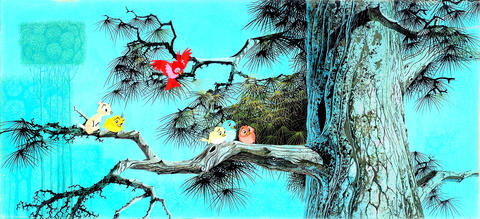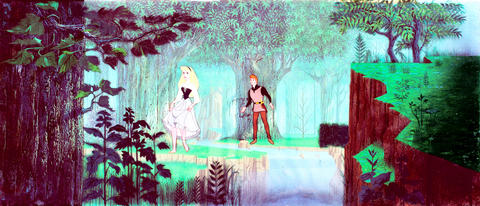A Japanese university plans to return about 250 pieces of original animation art to the Walt Disney Co that were mislaid in storage after traveling to Japan nearly five decades ago.
Disney said that the art - cels, backgrounds, preliminary paintings and storyboard sketches - was part of a collection that was handpicked by Walt Disney himself. It was sent to Japan in 1960 for a touring exhibition timed to coincide with the opening of the film Sleeping Beauty. The exhibition opened at Mitsukoshi Department Store in Tokyo in May of that year and traveled to 16 other stores throughout Japan.
"Walt wanted to explain every element of the animation process, so he chose artwork from all phases of production and a number of films," said Lella Smith, creative director of the Disney Animation Research Library in Burbank, California, which preserves the studio's artwork. "But the primary focus was Sleeping Beauty."

PHOTOS: NY TIMES NEWS SERVICE
Although most of the art is from that film, the collection also includes rare set-ups (cel and background combinations) from two Oscar-winning Silly Symphony cartoons: Flowers and Trees, the first Technicolor cartoon and the first film to win the Academy Award for animated short film, and the landmark short Three Little Pigs.
"The Flowers and Trees set-up is an extremely important piece," Smith said in an interview at her office in the library. She said other highlights included two backgrounds from the Nutcracker Suite and Rite of Spring sequences in the 1940 film Fantasia
Among other striking works is a sequence of images by the designer Eyvind Earle that show how he created the stylized forest backgrounds for Sleeping Beauty. The delicate clusters of leaves and intricately textured bark on the trees reflect Earle's interest in 15th-century French manuscripts and the painting of Van Eyck, and foreshadow his later serigraphs.

PHOTOS: NY TIMES NEWS SERVICE
After the department store tour, Disney donated the artwork to the National Museum of Modern Art in Tokyo. But the material was not considered a good fit for its permanent collection, so the museum gave the pieces to Chiba University to enhance the study of the visual arts.
Chiba's academic focus was on science, engineering and medicine, however, and the Disney art was consigned to a janitor's closet and forgotten until it was found by chance four years ago. Although the artwork suffered some damage because of dampness, the rarest pieces were sealed in frames, which protected them somewhat.
After a year of restoration work by technicians at Disney's Animation Research Library, some 200 works went on tour in Japan, along with 350 additional pieces lent by the studio in an exhibition titled The Art of Disney. The show toured seven museums around the country in 2006 and last year, including the Tokyo Museum of Contemporary Art. At the end of its run, Chiba University offered to return the artwork to Disney.
In a statement, Chiba University's president, Toyoki Kozai, said, "The response to the exhibit gave us a new appreciation for the historical and artistic value of these works."
Because the university was concerned about keeping them in good condition for the next generation, he said, it "concluded that entrusting them to Disney would be the best route to take."
In return, Disney is giving Chiba University high-resolution digital copies of the artworks and US$1 million for scholarships. But both sides said the deal should not be viewed as a sale.
In 1960 little value was placed on artwork from animated films, and cels were sold at Disneyland for a few US dollars apiece. Today animation art is prized by collectors, and a top-quality Earle background from Sleeping Beauty might sell for US$20,000 to US$30,000. Given the rarity of some of the pieces, it is hard to assign a value to the collection because nothing comparable has been offered for sale.
"There is no way to put a price on these works - they represent our artistic heritage," Smith, of Disney, said. "That said, their value as archival materials for study and research is very high." She added that when the works were discovered, they did not have much commercial value because of years of accumulated damage from mold.
Kozai said that Chiba University would channel the donated money into its overall educational programs and into research on art and animation and what he called "the sound growth of children."

The Taipei Times last week reported that the rising share of seniors in the population is reshaping the nation’s housing markets. According to data from the Ministry of the Interior, about 850,000 residences were occupied by elderly people in the first quarter, including 655,000 that housed only one resident. H&B Realty chief researcher Jessica Hsu (徐佳馨), quoted in the article, said that there is rising demand for elderly-friendly housing, including units with elevators, barrier-free layouts and proximity to healthcare services. Hsu and others cited in the article highlighted the changing family residential dynamics, as children no longer live with parents,

It is jarring how differently Taiwan’s politics is portrayed in the international press compared to the local Chinese-language press. Viewed from abroad, Taiwan is seen as a geopolitical hotspot, or “The Most Dangerous Place on Earth,” as the Economist once blazoned across their cover. Meanwhile, tasked with facing down those existential threats, Taiwan’s leaders are dying their hair pink. These include former president Tsai Ing-wen (蔡英文), Vice President Hsiao Bi-khim (蕭美琴) and Kaohsiung Mayor Chen Chi-mai (陳其邁), among others. They are demonstrating what big fans they are of South Korean K-pop sensations Blackpink ahead of their concerts this weekend in Kaohsiung.

Taiwan is one of the world’s greatest per-capita consumers of seafood. Whereas the average human is thought to eat around 20kg of seafood per year, each Taiwanese gets through 27kg to 35kg of ocean delicacies annually, depending on which source you find most credible. Given the ubiquity of dishes like oyster omelet (蚵仔煎) and milkfish soup (虱目魚湯), the higher estimate may well be correct. By global standards, let alone local consumption patterns, I’m not much of a seafood fan. It’s not just a matter of taste, although that’s part of it. What I’ve read about the environmental impact of the

Oct 20 to Oct 26 After a day of fighting, the Japanese Army’s Second Division was resting when a curious delegation of two Scotsmen and 19 Taiwanese approached their camp. It was Oct. 20, 1895, and the troops had reached Taiye Village (太爺庄) in today’s Hunei District (湖內), Kaohsiung, just 10km away from their final target of Tainan. Led by Presbyterian missionaries Thomas Barclay and Duncan Ferguson, the group informed the Japanese that resistance leader Liu Yung-fu (劉永福) had fled to China the previous night, leaving his Black Flag Army fighters behind and the city in chaos. On behalf of the